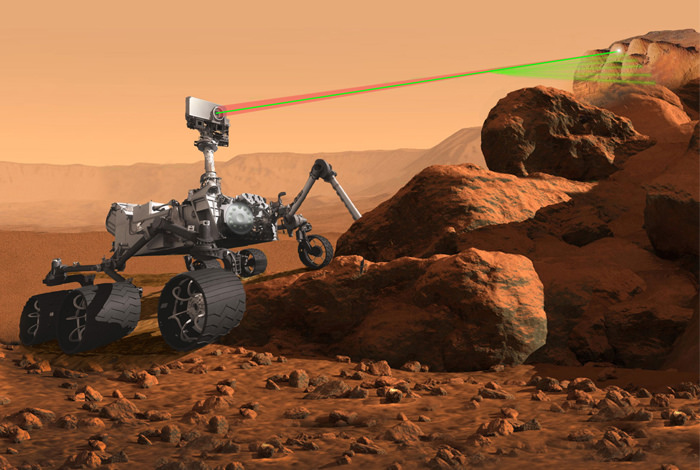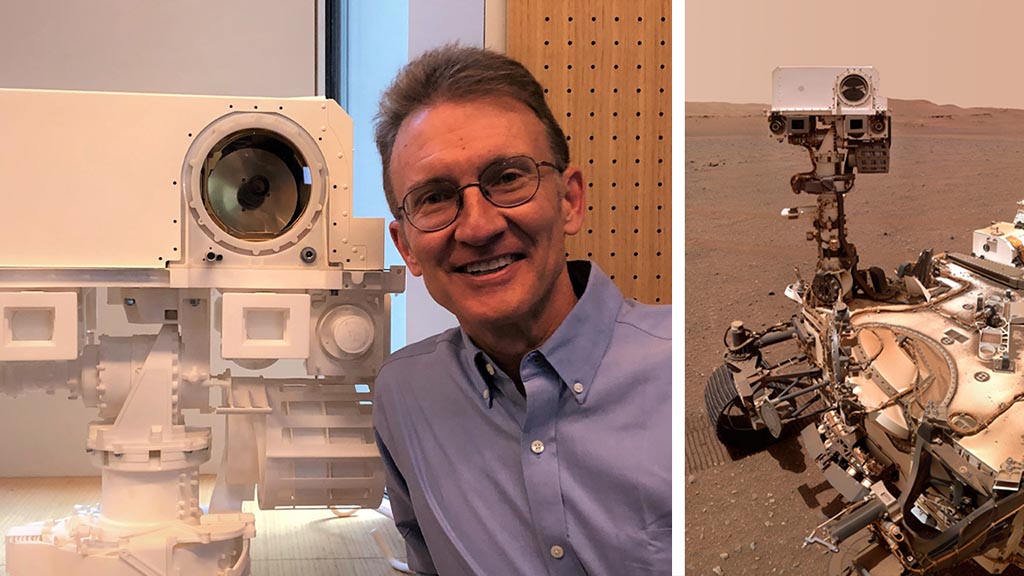We met Roger Wiens, Principal Investigator of SuperCam instrument installed on NASA’s Perseverance Mars Rover. Wiens is a Professor at Purdue University (EAPS) in West Lafayette, Indiana (USA) and the Senior Fellow of Los Alamos National Laboratory (LANL). Previously, he has been also the Principal Investigator of ChemCam instrument installed on NASA’s Curiosity Mars Rover. The latter landed on Mars in 2012, and it’s still active.
NASA’s Perseverance Mars Rover, that landed on Mars’ Jezero Crater on 18th of February 2021, has got a lots of scientific instruments. One of those is called SuperCam, an instrument that performs remote analyses of rocks and soils with a camera, two lasers and four spectrometers to seek organic compounds that could hold biosignatures of past microbial life on Mars, if it ever existed there.
SuperCam was developed in collaboration between the Research Institute in Astrophysics and Planetology (IRAP) of the University of Toulouse in France, the French Space Agency (CNES), Los Alamos National Laboratory, the University of Hawaii and the University of Malaga in Spain.
You have been the Principal Investigator of the Curiosity rover’s ChemCam instrument, and you are currently the Principal Investigator of Perseverance rover’s SuperCam. What is the difference between the ChemCam instrument and the SuperCam instrument? Do they both have the same goal?
ChemCam is on the Curiosity rover that landed in 2012. SuperCam is her younger sister, landing on Mars in 2021 on the Perseverance rover. Both are mounted about 2 meters above the ground on the top of the masts of their respective rovers. ChemCam gives us the abundances of elements (silicon, iron, aluminum, etc.) of rocks and soils up to about 7 meters away by firing a laser beam in short pulses focused to a very small spot (about 0.2-0.4 mm). The impact of the laser pulse creates a small flash from super-hot material that is removed from the surface. We use a 110 mm diameter telescope to collect the light, and an optical spectrometer to plot its intensity by wavelengths.
The elements that are present have characteristic peaks at certain wavelengths, and by calibrating this spectrum, we determine the elemental compositions. ChemCam also takes very high resolution images of the laser targets and other objects of interest. SuperCam uses this laser technique too, and also adds one more laser technique (Raman spectroscopy), infrared vision and a microphone. The Raman and infrared spectroscopies help us understand the mineral composition, for example, whether some of the rock has turned into clay minerals, indicating the presence of water in the past.
Credit: Los Alamos National Laboratory
Why is it important to study the rock of Mars using a laser beam?
Mars is a dusty planet. Each instrument that is expected to operate in such an environment must have a way to remove the dust in order to analyze the rocks. The laser pulses create a small shock wave. The “puff” from the shock wave blows the dust away from the analysis area. The laser technique is unique—there are no other good ways to remove dust from distances of up to 7 meters. It’s like a very long arm that can reach out and brush clean our samples before we analyze them.
ChemCam and SuperCam’s analyses of rocks on Mars are part of NASA’s mission to understand the Red Planet, first, whether it was habitable in the past, and second, whether it ever had life. Our instruments have shown that Mars was may have been very habitable about 3 billion years ago. We have found abundant evidence of rivers and long-lasting freshwater lakes. We’re still working to understand the ancient climate of this strange planet.

Credit: NASA
What are the most important discoveries and investigations made by SuperCam?
The most fascinating aspect has been exploring an ancient river delta. It’s the first time to ever investigate such a feature on another planet. The rocks, consisting of hardened river sediments, have recorded the meanders (twists and turns) of the water channels of the ancient river and tell us about the quality of the water in the lake. We have found out that at times, the lake level receded, and the lake became saline.
SuperCam’s camera has observed large boulders, up to one meter diameter, in the delta sediments. These boulders were a surprise, and indicate that the river must have had flash floods that carried these boulders downstream. This finding suggests that Mars’ climate had some extreme weather events. What would have caused this weather, we are not sure. It might have been large meteorite impacts or large volcanic eruptions.
The SuperCam instrument also has a microphone, which records the sounds of Mars. You also managed to record the movements of a dust devil, a tiny tornado of dust and grit. Why is it important to listen to the sounds of Mars? What is the difference between Mars sounds and Earth sounds?
Yes! We are the first to ever hear the sounds of Mars. They consist of wind—and in one case, dust grains hitting the rover during a strong gust—and also the sounds of the rover and its airborne companion, Ingenuity. We also have heard the “zapping” sounds of the small laser-produced explosions. From these recordings, we have learned how sounds are generated and how they travel through the thin Mars atmosphere. That atmosphere is 95% carbon dioxide, and only 1% as thick as air on Earth. As a result, sounds travel only quite poorly through that atmosphere, and very different from Earth. The speed of sound is much slower, at only about 250 meters per second compared to 340 meters per second on Earth, and unlike on Earth, the sound speed on Mars varies with the frequency of the sound. Listening to music on Mars would be a very strange experience.
Credits: The Guardian / NASA/JPL-Caltech
Credits: Space.com | imagery & audio: NASA/JPL-Caltech | produced & edited by Steve Spaleta

